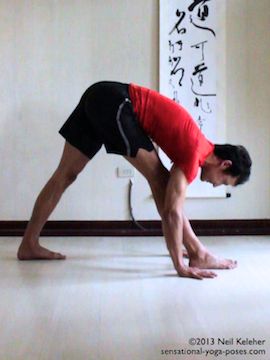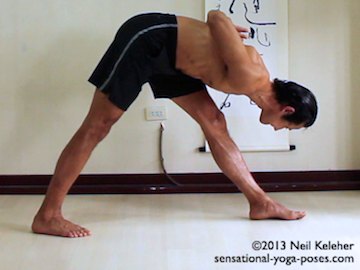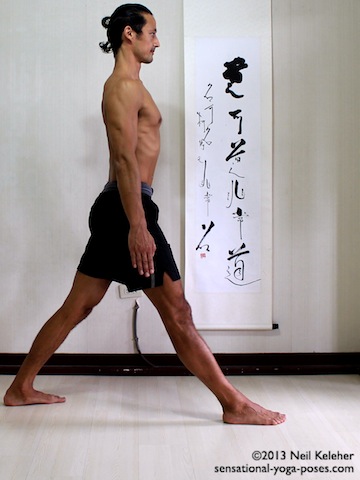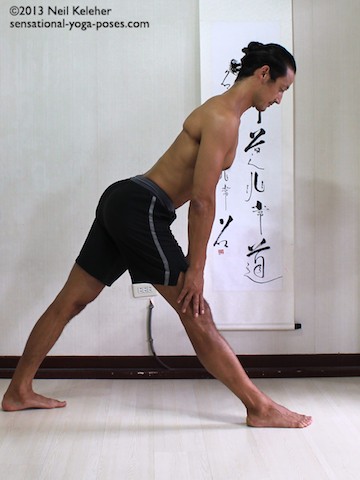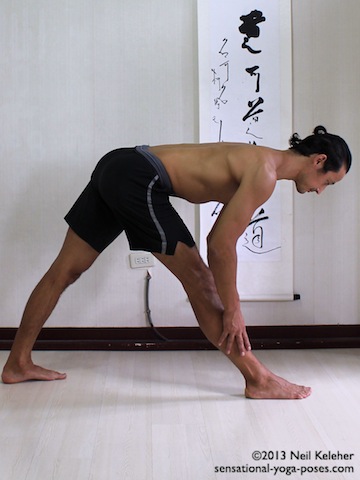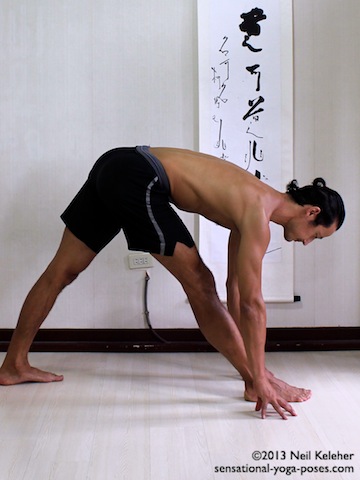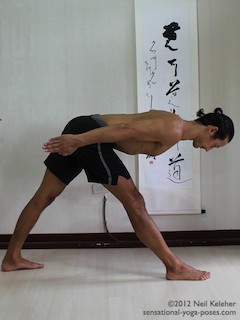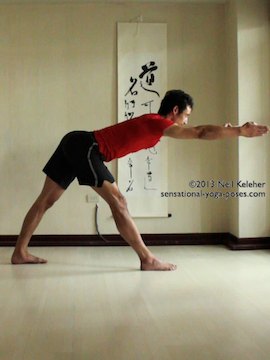Using Parsvottanasana (Pyramid Pose)
To Strengthen and Stretch the Hamstrings
In Parsvottanasana, or Pyramid Pose, you bend forwards with one leg forward and the other back. Both knees stay straight and the feet are both flat on the floor.
While bent forwards you can rest your hands on the floor, or on your front leg (or on a chair or yoga blocks.) You could also bend forwards and keep your hands lifted. A common "hands lifted" variation of pyramid pose is called reverse prayer pose because your hands are behind your back in prayer position.
You can use this pose to stretch the hamstrings and/or strengthen them.
You can read the reverse prayer article for how to work towards the reverse prayer hand position.
Getting into Parsvottanasana
To get into pyramid pose, step one leg back. You can experiment with different distances from front to back but as a starting point have the legs about a legs distance apart from front to back so that your legs and the ground between them form a roughly equilateral triangle (when viewed from the side).
- Point your front foot and front knee straight ahead.
- Turn your back foot out about 20 to 30 degrees so that your foot points forwards and outwards.
- Point your back knee in the same direction as the toes of your back foot.
- Turn your pelvis so that it faces the same direction as your front foot.
Looking at yourself from the front, your feet can be hip width apart from heel to heel. You could also have your heels in line or you could line up your back instep with your front heel. A wider stance makes it easier to balance.
Focusing on your Feet or Focusing on Your Spine
When first learning this yoga pose you could focus on your feet or you could focus on your spine. Once you are used to feeling both in relative isolation, you can focus on feeling both.
Foot and Heel Actions
While standing upright, lift the center of your inner and out arches and press down through your heels and the roots of your big toe and little toe.
As you activate your feet try to stack your heel bones (talus and calcaneus) so that both your inner and outer ankle joints feel open.
Bend forwards while keeping this foot action. Once you bend forwards and place your hands on the floor you can practice relaxing your feet and then re-activating them. Reactivate your feet prior to standing and see if you can keep them active until you are upright.
Lengthen Your Spine
With your feet active and while standing upright, draw your ribs up away from your pelvis and open the spaces between your ribs so that your ribcage feels "open."
Pull your head back and up away from your ribcage so that your neck feels long.
Slowly bend forwards while keeping your spine long, and place your hands on your front leg or if they can reach, on the floor either side of your feet.
As with the feet, once your hands are on the floor, you can relax your spine, then practice reactivating it.
Allow Your Hamstrings to Relax in Pyramid Pose
When your are bent forwards in pyramid pose with your hands on the floor or on yoga blocks, you can focus on relaxing your hamstrings. If your hands are on the floor you can use your arms to help support the weight of your body so that your hamstrings don't have to. They can relax.
Reactivating and Strengthening Your Hamstrings in Parsvottanasana
Activating your feet, you can try re-activating your hamstrings prior to lifting your hands. If you stay bent forwards with your hands lifted, you can use this position to strengthen your hamstrings. Then put your hands down so that your hamstrings can relax.
You may find that if you repeat these actions, each time you relax your hamstrings you can actually bent a little further forwards.
To make your hamstrings work a little harder when lifting your hands, focus on lengthening your spine forwards, as if pulling your ribcage and head away from your pelvis. To make your hamstrings work even harder you can reach your arms forwards.
Engage Your Buttocks in Pyramid Pose
Do you have difficulty keeping your hamstrings relaxed?
With your hands on your leg or on the floor, you may find it easier to relax your hamstrings if you engage your buttocks and the sides of your thighs and hips.
Try to slowly contract your buttocks and then slowly release them repeatedly.
You may find that you can tilt your pelvis forwards more as you release your buttocks. Or you may find that you can also tilt your pelvis forwards more while your buttocks are engaged.
Using a Muscle Assist In Parsvottanasana
To add a muscle assist to this hamstring stretch work at engaging your quadriceps and hip flexors. You can focus on your front leg or your rear leg or use both legs. Think of this as a muscle assisted hamstring stretch.
For exercises to help you activate your quadriceps and hip flexors check out muscle control.
Published: 2011 07 16
